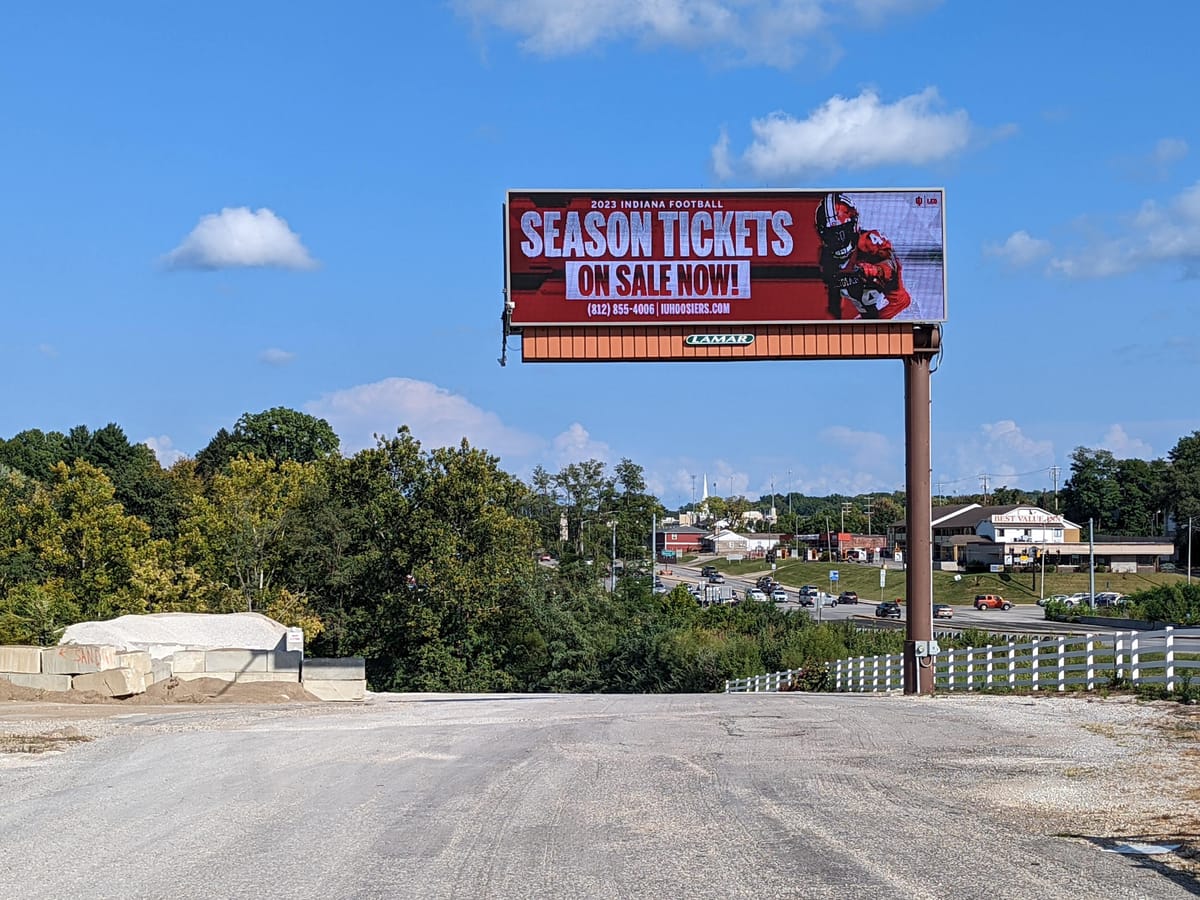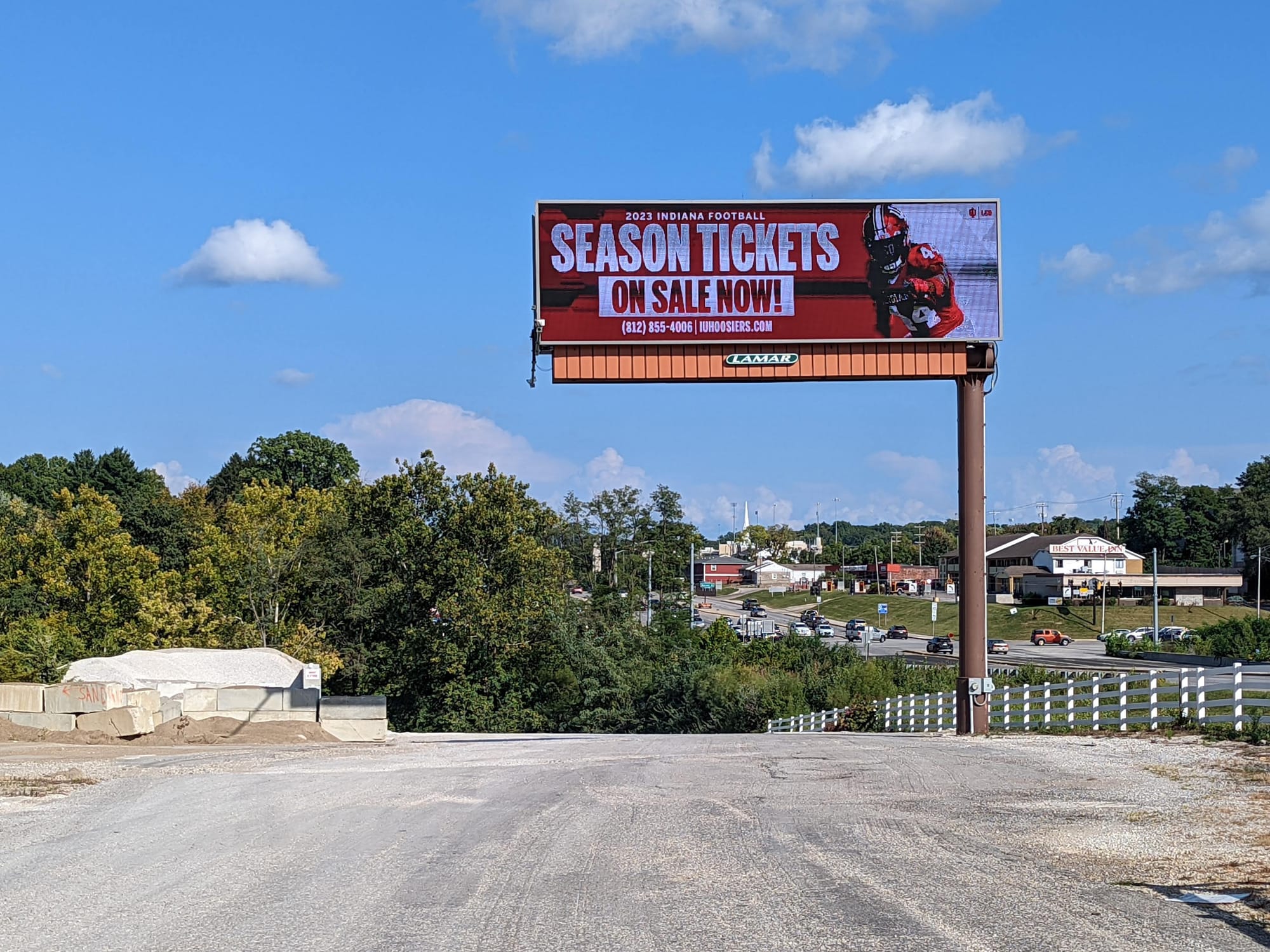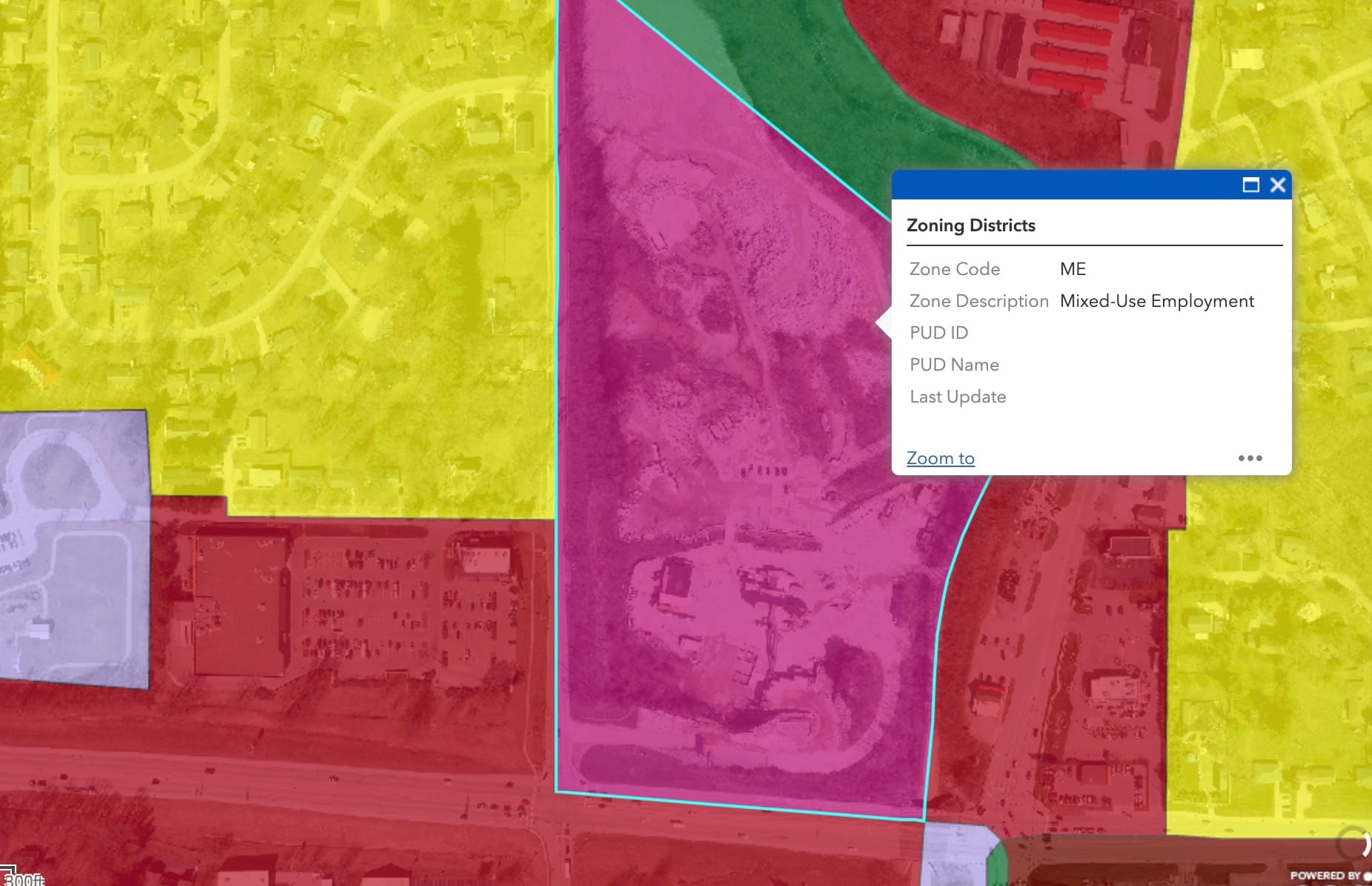Bloomington looks to ban billboards: Even if outdoor ad firm wins current legal case, sign could be nixed



Last Monday, Bloomington’s plan commission heard a proposal from mayor John Hamilton’s administration to amend the city’s zoning code for signs.
The amendment would effectively make all billboards in Bloomington disappear by 2031. That includes the one off Kinser Pike next to the SR 45/46 bypass, which is currently subject to litigation.
Last year, after the billboard’s owner, Lamar Outdoor Advertising, converted the billboard face to a digital display, Bloomington cited the company for violation of the UDO’s regulations on electronic reader boards.
Lamar is fighting the citation. Even if Lamar wins the court case, the company could eventually have to take down the billboard—if the amendment to the city’s unified development ordinance (UDO) is eventually approved by the city council.
Under Bloomington’s current UDO, most billboards are lawful but nonconforming signs, which means they can stay, but no new billboards can be installed.
But under the ordinance proposed to the plan commission on Monday, both kinds of billboard—free standing signs and off-premise signs—would have to be removed or modified to come under compliance.
There’s a schedule for removal or non-compliance, based on the zoning district where the sign is located. The schedule applies to some zoning districts starting in 2029. But by the start of 2031, billboards in all zoning districts would have to be removed, or altered to fit Bloomington’s zoning code.
Last Monday, the plan commission balked at the planning staff’s request to waive the required second hearing for such a zoning change, even while expressing no love for billboards. As plan commissioner Karin St. John “I don’t like billboards at all. I can’t think of one that I like.”
St. John added, “But I do like the public process. And it does feel like there hasn’t been enough input from the people that this really financially impacts.”
Plan commissioner Jillian Kinzie had earlier in the meeting commented on the fact that no one attended the meeting to object: “I guess I’m surprised that there aren’t any billboard owners who are present to oppose this.”
Drawn out from city attorney Mike Rouker in the discussion was the fact that no one from the city had notified Lamar or other billboard owners that the plan commission would be considering the ordinance that would affect their properties.
Responding to a question from Kinzie about the city’s effort to notify Lamar, Rouker said, “We are in active litigation with them. So, the nature of our relationship may not be absolutely the best.” He continued, “But we did not speak with them about this ordinance ahead of this plan commission hearing—if that’s the direct question.”
Rouker added, “I would say, I can venture a guess what their perspective on this particular ordinance would be, but I’m not gonna speculate in public.”
The plan commission’s vote last Monday was unanimous—to deny the administration’s request to skip the commission’s normal second hearing. That means the billboard ban will be heard again in front of the plan commission at its next meeting, on Oct. 9. The amendment could be in front of the city council before the end of the year.
The litigation to which Rouker referred involves the billboard at Kinser Pike and SR 45/46 bypass.
The court case arose in 2022 after Lamar converted the static sign to a digital display. Bloomington first cited Lamar for a violation of the UDO, because the city said the digital sign conversion amounted to installation of a new sign, in violation of the UDO.
Lamar responded to the first citation based on a 2010 variance that had been granted to Lamar by Bloomington’s board of zoning appeals. At that point, the city had apparently not factored the 2010 variance into its thinking, and withdrew the notice of violation. In withdrawing the notice of violation, Rouker wrote to Lamar’s legal counsel that “the matter is considered closed.”
But the city followed up with a second notice of violation, this time based on violation of the UDO’s standards for electronic reader boards.
Lamar appealed the second notice of violation to Bloomington’s board of zoning appeals, but lost the appeal on a 3–2 vote. Lamar’s next step was to file a legal action in the Monroe County circuit court.
The history of the billboard, which is recited in Lamar’s legal complaint, dates back to 2007, when then-owner Hoosier Outdoor Advertising Corporation struck a bargain with the city of Bloomington. A four-panel outdoor advertising sign would be removed from South College Avenue, but in exchange, the city of Bloomington agreed to support Hoosier Outdoor’s variance for building a two-panel sign at some location acceptable to both Hoosier Outdoor and the city. That location turned out to be Kinser Pike at the SR 45/46 bypass.
After acquiring Hoosier Outdoor’s assets, Lamar asked Bloomington’s board of zoning appeals for a variance from the UDO, to build the sign at that location. That variance was granted in 2010.
Lamar is relying on the 2010 variance for its conversion of the billboard in 2022 from a static display to a digital display. Under the terms of the 2010 variance, Lamar contends that there is just one regulation in the zoning code that is called out for compliance—the lighting standard. And Lamar says the sign, even after conversion to a digital display, complies with the UDO standard for the amount of light that is emitted from the sign.
Another argument that Lamar is making is that the sign is simply not an “electronic reader board,” which is commonly understood to refer to a sign with changeable copy, for example with scrolling text. In contrast to such signs, like schools or banks often use, Lamar contends that its billboard is a sign that changes its entire face.
In its answer to Lamar’s complaint, Bloomington disputes Lamar’s contention that the wording of the variance means the billboard has to meet only the UDO’s lighting standard. The city further disputes Lamar’s contention that the billboard is not an electronic reader board.
Lamar’s billboard stands in a district that’s zoned ME (mixed-use employment). Under the proposed new ordinance, billboards in ME zoning districts would be subject to removal by Jan. 1, 2031.
The schedule for Lamar’s court case is laid out in a court order from Monroe County circuit court judge Kara Krothe, who is hearing the case. There’s a timeframe laid out for the filing of briefs and replies that culminates in oral arguments to be heard on Dec. 14, 2023.




Comments ()